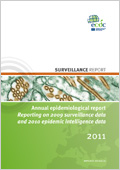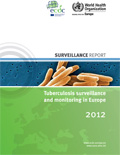 The
ECDC communicable disease threats report is a weekly bulletin intended
for epidemiologists and health professionals in the area of communicable
disease prevention and control. Summarising information gathered by
ECDC through its epidemic intelligence activities regarding communicable
disease threats of concern to the European Union, it also provides
updates on the global situation and changes in the epidemiology of
communicable diseases with potential to affect Europe, including
diseases that are the focus of eradication efforts.
The
ECDC communicable disease threats report is a weekly bulletin intended
for epidemiologists and health professionals in the area of communicable
disease prevention and control. Summarising information gathered by
ECDC through its epidemic intelligence activities regarding communicable
disease threats of concern to the European Union, it also provides
updates on the global situation and changes in the epidemiology of
communicable diseases with potential to affect Europe, including
diseases that are the focus of eradication efforts.http://www.ecdc.europa.eu/en/publications/Publications/CDTR%20online%20version%2015%20June%202012.pdf


 The World Health Organization (WHO) has played a leading role in developing
The World Health Organization (WHO) has played a leading role in developing http://whqlibdoc.who.int/hq/2003/WHO_CDS_CSR_RMD_2003.2.pdf
http://whqlibdoc.who.int/hq/2003/WHO_CDS_CSR_RMD_2003.2.pdf Comprehensive quality systems are essential in order to ensure the validity of results from
Comprehensive quality systems are essential in order to ensure the validity of results from The continuing emergence of pathogenic microorganisms that are resistant to first-line antimicrobials is a cause of increasing concern. This emergence is associated with higher levels of mortality
The continuing emergence of pathogenic microorganisms that are resistant to first-line antimicrobials is a cause of increasing concern. This emergence is associated with higher levels of mortality
 Under Dutch law, preventive youth healthcare organisations have a duty to ensure the early
identification of children with health or developmental problems. Similarly, municipalities
have a duty to monitor young people’s health at least every four years. For problem
identification and monitoring, both individual and collective, these organisations often use
self-report questionnaires. The overall aim of this thesis is to study various methodological
and validity issues related to the use of self-report questionnaires among young people in a
preventive youth healthcare setting. Seven specific research questions are derived from the
Rotterdam Youth Monitor (RYM), a longitudinal youth health surveillance system integrated
into preventive youth healthcare in the greater Rotterdam area.
Under Dutch law, preventive youth healthcare organisations have a duty to ensure the early
identification of children with health or developmental problems. Similarly, municipalities
have a duty to monitor young people’s health at least every four years. For problem
identification and monitoring, both individual and collective, these organisations often use
self-report questionnaires. The overall aim of this thesis is to study various methodological
and validity issues related to the use of self-report questionnaires among young people in a
preventive youth healthcare setting. Seven specific research questions are derived from the
Rotterdam Youth Monitor (RYM), a longitudinal youth health surveillance system integrated
into preventive youth healthcare in the greater Rotterdam area. The objective of this thesis was to quantify three-dimensional ocular stability
in response to head movements in healthy human subjects and in patients
with various types of peripheral vestibular disorders. Despite a large increase
in our knowledge from animal and human studies about the neuronal circuitry
that regulates three-dimensional (3D) vestibular organization (for a recent
review see Angelaki and Cullen 2008), its application to clinical practice is still
a long way ahead. In order to bridge this gap, we explored in healthy
subjects the naturally occurring variability in 3D vestibulo-ocular stabilization
and compared these results with changes that occur in 3D vestibulo-ocular
stabilization in patients with various types of unilateral vestibular disorders.
The objective of this thesis was to quantify three-dimensional ocular stability
in response to head movements in healthy human subjects and in patients
with various types of peripheral vestibular disorders. Despite a large increase
in our knowledge from animal and human studies about the neuronal circuitry
that regulates three-dimensional (3D) vestibular organization (for a recent
review see Angelaki and Cullen 2008), its application to clinical practice is still
a long way ahead. In order to bridge this gap, we explored in healthy
subjects the naturally occurring variability in 3D vestibulo-ocular stabilization
and compared these results with changes that occur in 3D vestibulo-ocular
stabilization in patients with various types of unilateral vestibular disorders.